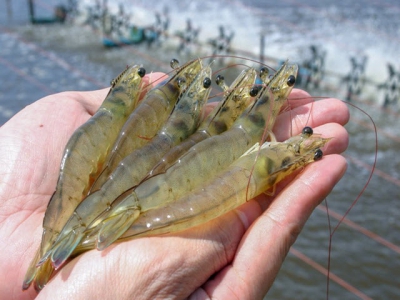Shrimp given plasma can grow almost 10% bigger, study finds

Feed components supplier, Darling Ingredients, has released new research that it says demonstrated nearly 10% growth in shrimp fed with plasma.
Research into the use of the blood product in the pig feed segment has been well established over the last three decades, but this is the first study into the compound as a replacement for fishmeal in shrimp diets, said Lourens Heres, manager of global technical support at Darling.
“We collect plasma mostly from pig’s blood by separating the red blood cells from the rest and spray-drying it so all the active proteins in blood are not damaged by heat treatment,” he said.
“We use byproducts that have a high nutritional value. If you compare our products in carbon footprint with soy or fishmeal, ours have the benefit because our footprint is relatively low.”
To conduct the shrimp study, the researchers replaced fishmeal with plasma in shrimp diets and assessed the crustaceans’ performance over the next six weeks.
They found the better growth in those given plasma, along with a high level of IgT antibodies in the shrimp’s intestinal villi.
“Antibodies have a central role in the immune system, they also capture viruses and bacteria and protect the intestinal wall from infection,” said Dr Heres.
“The integrity of the cell stays better with plasma, there is less inflammation. Also in this experiment we could show that the villi lengths were longer and better able to absorb all the nutrients in the feed, which explains the better growth.”
The researchers identified an average of 1 gram weight difference in those fed with plasma. “On scale, this is significant,” Dr Heres added.
As a relatively expensive protein to produce, plasma will ideally be used to replace fishmeal in low quantities. But in combination with other proteins, it could give more additive effects in improving the health of the shrimp, said the company.
Research gaps
Plasma has been used by animal feed companies for around 30 years. When it started to gain traction, specialized aqua feed was not commonplace, so this area missed out on its own research for decades. But with the pressing need for the industry to find antibiotic alternatives, “everyone is looking for these kinds of ingredients,” said Dr Heres.
“We are still getting experience in this field, and we are also looking for ways to do more research in aqua. Our results confirm, more or less, the research we already know from piglets. In piglets, you already see better survival and better feed intake through plasma.
“In chickens you see better survival and better feed conversion ratios, so the new research confirms the results already known in these other areas,” he added.
Darling is now in the process of sharing its results with fish feed companies, in a bid to persuade them that plasma may be the right ingredient to make better fish and shrimp feeds.
“Growth is important in the end, but you first have to have survival, so we mainly see it being used in juvenile shrimp.”
Có thể bạn quan tâm
 Least-cost formulation software in shrimp aquafeed production - Part 2
Least-cost formulation software in shrimp aquafeed production - Part 2 The success of aquafarmers depends on several parameters. One of the most important ones is the quality of aquafeeds used for broodstock maturation
 Development of new and real-time PCR for detection and quantification of NHPB
Development of new and real-time PCR for detection and quantification of NHPB Newly described method an additional diagnostic tool for confirmation of the bacterial pathogen necrotising hepatopancreatitis
 Management of non-hazardous solid waste in shrimp farms
Management of non-hazardous solid waste in shrimp farms The concept of “non-hazardous solid waste” is the generic name of any type of residual product that can be solid, semi-solid and generally